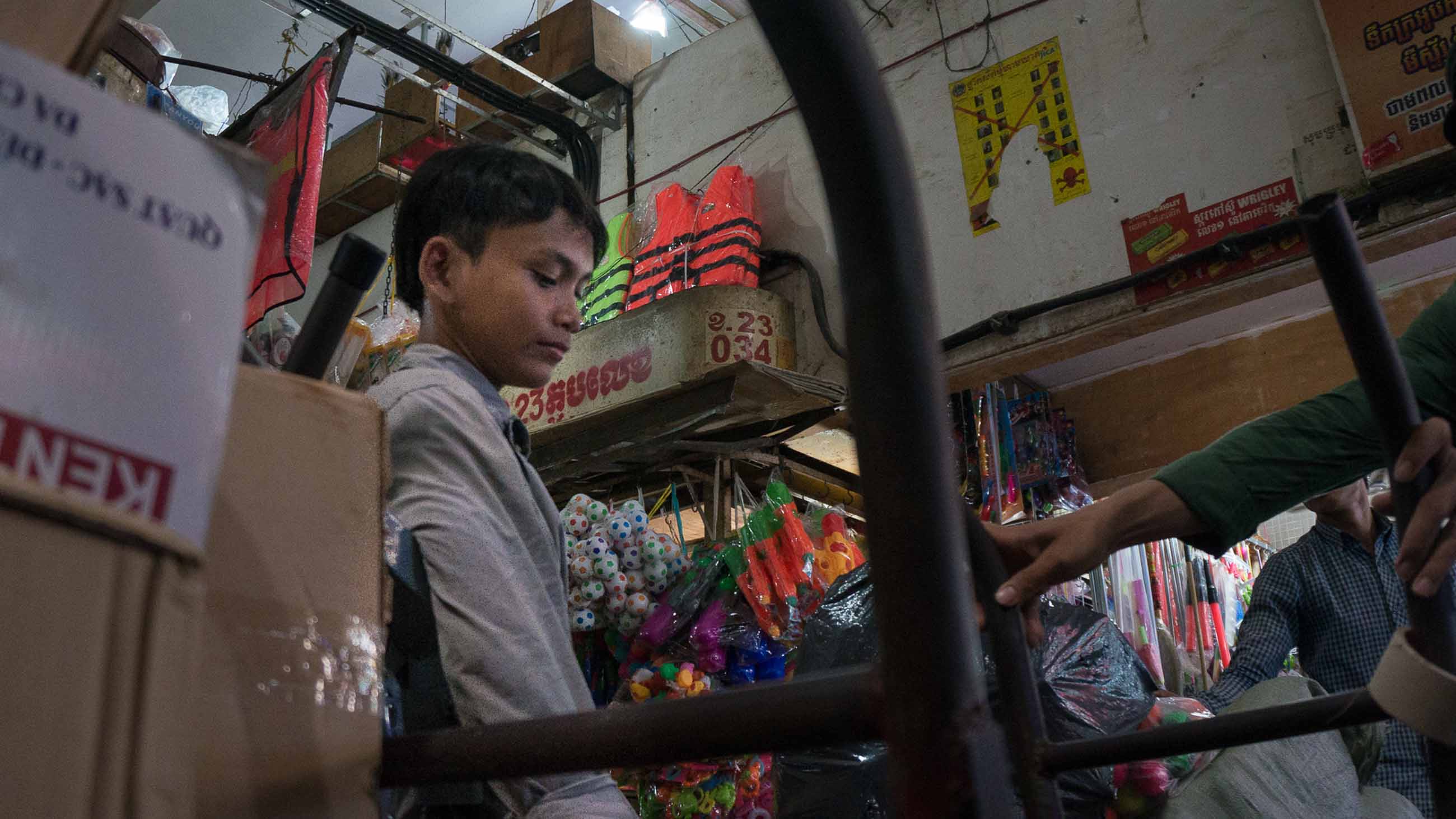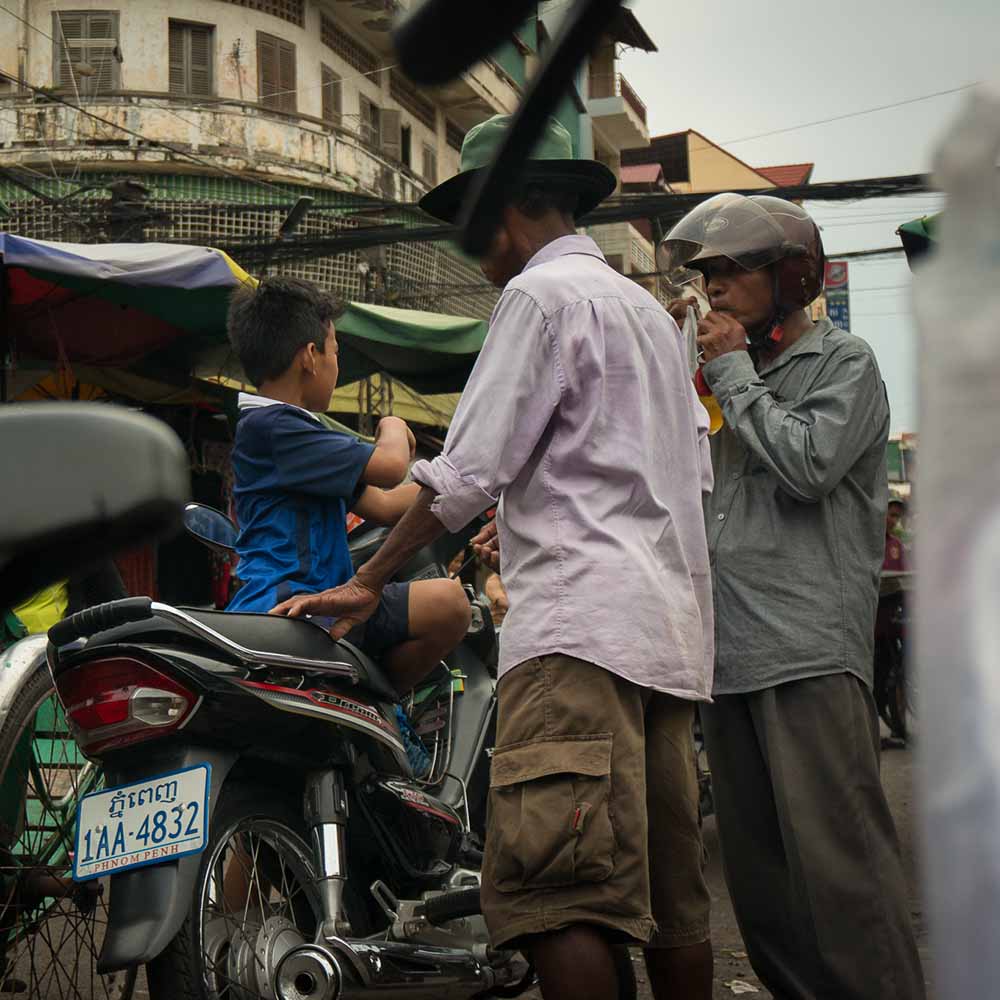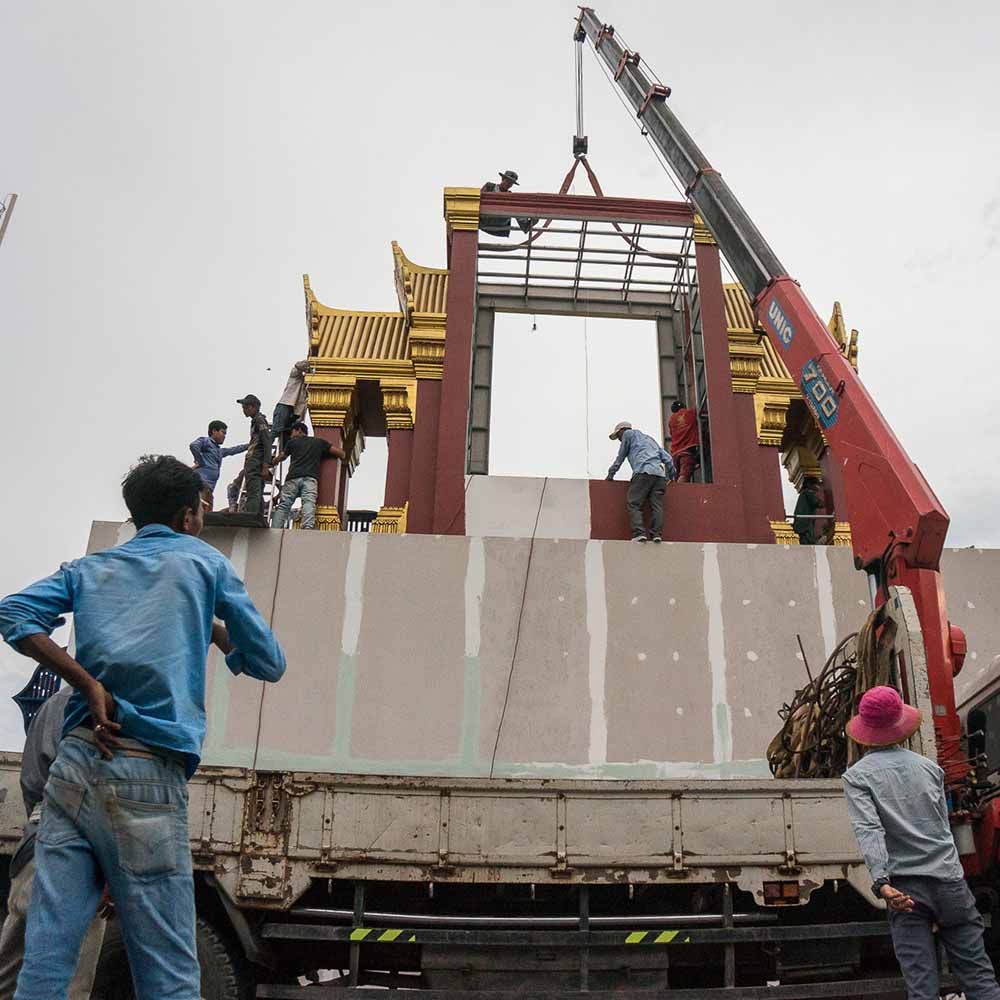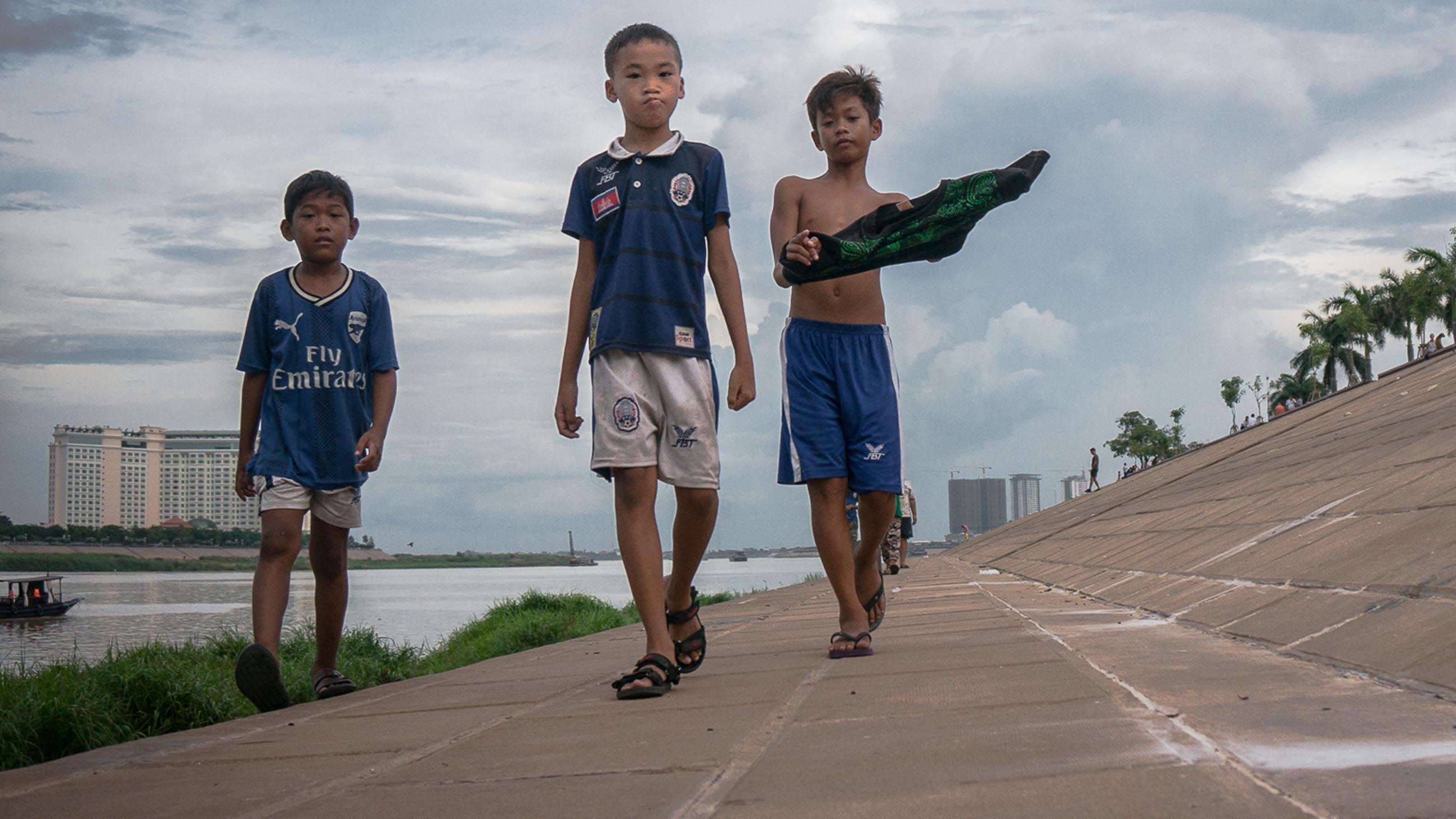As Cambodia Educates More Girls, Boys Fall Through the Cracks
Sixteen-year-old Sokha works as a delivery boy ferrying boxes on his trolley at O’Russy Market in Phnom Penh, Cambodia, where scores of vendors sell everything from cuticle cutters to bedspreads. He earns about $100 a month here, sending almost half of it to his home village near the Vietnam border. Sokha moved to the capital to work after dropping out of school two years ago, when his father fell ill. “We had to sell our cows and a rice field to pay for his medicine,” Sokha says. Now, far from his family, he can’t afford much. “I’m so bored,” he says. “But I don’t miss school — I wasn’t very good at it.”
Sokha is one of many children who have dropped out of school to work in Cambodia, a country where education is not compulsory. Only half of Cambodia’s 12 to 14 year olds attend school. But government figures show boys are particularly likely to leave school, often because their families expect them to be breadwinners.
The disparity indicates an alarming and growing problem: Successful educational interventions have improved girls’ graduation rates — but boys are being left behind. Nationwide data shows girls now complete lower secondary school nearly 20 percent more often than boys; in some provinces, like Siem Reap, home of the famous Angkor Wat temples, nearly 1.5 girls complete school for every boy.
Historically, women in Cambodia had problems pursing an education, not least for being banned from the monastic schools that still provide a rudimentary education for thousands of boys. “Given that historically girls faced more barriers to education than boys, focus has been placed on addressing these key barriers,” says Iman Morooka, spokesperson for UNICEF Cambodia. “This has led some NGOs and donors to target their interventions to girls.”
Nor is it just international donors who’ve overlooked boys in their programming. Cambodia’s national Gender Mainstreaming Strategic Plan in Education, introduced in 2016, for example, includes a number of interventions targeting girls — but none for boys. Indeed, the term “girls” occurs 101 times in the document, while the term “boys” occurs twice. (Officials at the Ministry of Education, Youth and Sport did not respond to requests for further comment.)
Experts say poverty may also contribute to this new disparity between genders. Magnus Saemundsson, first secretary and education specialist at the Embassy of Sweden, says there’s currently an abundance of unskilled jobs available for young boys. “The booming construction industry need[s] a large number of unskilled workers.”
Jarrett Davis, a social research consultant at the nonprofit Up! International, agrees. “It’s assumed that boys will be able to make more money, so there is a lot of pressure from families pushing them into work sooner and [so they’re] not finishing school,” he says. “Girls are seen as vulnerable,” Davis says, so society’s response is to protect them and keep them close to home. In his research with children in Southeast Asia, Davis noticed that boys were not only more likely to be out of school, but also more likely to suffer physical and sexual violence.
But both Saemundsson and Davis support changing the way educational programs currently account for gender. “To make a real impact on retention, the scholarship amounts [provided by donors and the government] have to increase substantially,” Saemundsson said. “The main reason for drop-outs, both for girls and boys, is the possibility of getting a job through migration or in the neighborhood.”
Davis, on the other hand, thinks gender-targeted programs exacerbate the problem. “Funding for programs needs to avoid gender assumptions like women are fragile, and men are invulnerable and don’t need protection,” Davis says. “If males are dropping out of school, [that will] also harm females.”



Unfortunately, with a high proportion of Cambodia’s education budget coming from outside donors — in 2016, about 20 percent of Cambodia’s education funding came from foreign aid such as the European Union and the World Bank — the country’s programs are closely linked to worldwide funding trends. Often, charities and corporations donate with strict requirements about where their money should go. A 2016 report by the NGO Education Partnership (NEP) explains that NGOs often try to follow donor trends in order to secure funding, which makes their projects beholden to outside influences.
A development worker familiar with flows of international aid who wished to remain anonymous puts it simply: “Sometimes these donors have limited grounding in the realities of the countries they are giving money to.” The worker adds, “The problem is there’s very little opportunity for the voices of people who need the money to be heard.”
Figuring out how to invigorate boy’s education programs without taking away from girls’ recent success will be tricky. Women remain highly underrepresented in the Cambodian government and business community, and successful interventions are still needed. Perhaps the answer is to find a way to reach boys like 11-year-old Leng Pov, for example, who’ve already dropped out of school — and who face major hurdles in returning to education. Pov now works on the street, helping his blind father. He’s the only son — his younger sister will enroll in school as soon as the family can afford it.
Outside the hulking O’Russy Market, Pov rests his hand on his father’s shoulder as the old man sings Cambodian folk songs into a karaoke microphone. Busking is a common way for blind people to earn money, and Pov keeps a protective eye on an upturned hat, half-full of tips from passers-by.
“I haven’t gone to school since we moved here six months ago,” he says. His mother is sick and confined to their small home with Pov’s younger sister. “I want to learn to be a mechanic in the city,” Pov says. “It’s too late to go back to school now, so this is my best option.”
Nathan A. Thompson is president of the Overseas Press Club of Cambodia.











Comments are automatically closed one year after article publication. Archived comments are below.
I think that Cambodia would need to learn from its neighboring country, Thailand. Back in the 1940s or 1950s, Thailand was still very poor country as in Cambodia today. However, with the emphasis and persistence in providing adequate education to all of the Thai citizens, Thailand has become the middle income country since 1980s and its citizen has enjoyed high level of economic development, stability and prosperity. In fact, beside China, Thai companies have been investing heavily in Cambodia to create many medium and large businesses in Cambodia. Many of the unskilled Cambodians and Burmese are now ending up in Thailand as either seasonal or permanent unskilled workers in Thailand by fulfilling many of the jobs in Thailand.
As long as Cambodian government cannot or is unwilling to provide the adequate education to its citizens, Cambodian people will continue to suffer from the economic disadvantages in their country.
One of the quicker solutions is by opening the country to all of the foreign investments in Cambodia. This will immediately provide a “boost” in the Cambodian economy while working to develop their citizens through the provision of the adequate education in their citizens.
It is interesting news. I will translate Eng to Korean.
With the continuing dictatorship that is embracing Cambodia via China’s aid supported by Hun Sen and the CCP the poverty level in Cambodia will rise. You only have to look at the rise in construction taking place in Cambodia that is fueled by fly in fly out workers from China. Until the economic countries driving growth take a stand against Cambodia and place embargoes on Cambodia like was done to South Africa in the eighties the level of education along with prosperity will continue to fall.